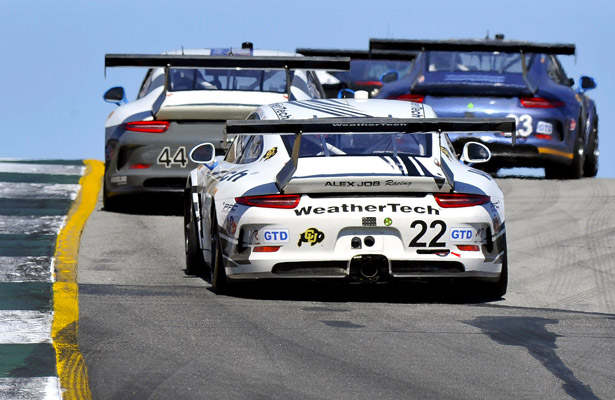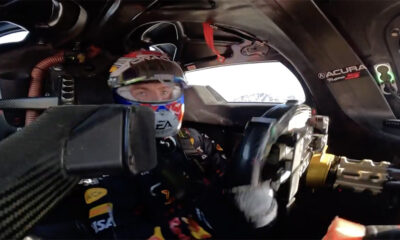
Photo: IMSA
Less than one week after IMSA’s reversal on the driver pairing regulations for 2015, teams and drivers are left with mixed feelings and opinions on how the GT Daytona class should be structured in the TUDOR United SportsCar Championship next year.
IMSA initially announced changes to the regulations on Nov. 7, stating that only one Bronze or Silver-rated driver would be required for three or four-driver lineups for the Prototype Challenge and GTD classes, instead of the two that were mandated this year.
Due to competitor feedback, the decision was reversed for PC competitors on Nov. 10, with GTD also reverting to the current 2014 regulations last Friday, via an email sent to teams from IMSA’s Managing Director of Racing Operations, Simon Hodgson.
The recent change back, however, has caused issues for a handful of teams in the GTD paddock, including IMSA stalwart Alex Job, who had already secured contracts with Gold and Platinum-rated drivers to complete the lineup in one of his Porsche 911 GT Americas.
“Based on the [original] memorandum that was sent out, I had made deals that were in place just on one Silver driver,” Alex Job told Sportscar365. “I was then very displeased to get an email one week later saying that they were going to undo it and put it back the way it was. Now I’ve got a big problem.
“Quite frankly I’m extremely upset with the whole situation right now and until some decision is made, I’m putting both programs on hold.”
Job, who recently tested at Daytona with his two-car Porsche squad in preparation for next year’s TUDOR Championship season, is calling for the regulations to go back to the proposed 2015 method, which would allow an influx of professional drivers in the class for the endurance races.
“There are some driver rental programs in GTD, but the bulk are funded programs by a Silver driver principal or sponsorship program,” Job said. “It’s a very difficult situation for a lot of drivers.
“There’s a lot of professional drivers out there that make a living and rated as Gold that can’t get a ride now because those seats have to be filled by Silver drivers. And quite frankly, there’s a shortage of funded Silver drivers.
“I can understand that some teams have to function on a driver rental program but on the other hand, this is professional racing. Maybe some of those programs should be in support series, which are based almost completely on driver funded programs.”
TRG-AMR team principal Kevin Buckler, however, doesn’t share the same viewpoint as Job, as Buckler was one of the teams that had pushed for IMSA to change back to the 2014 regulations, largely driven on cost containment.
“It’s completely correct now and the way it should be,” Buckler said. “It’s a complete travesty that they would even think about switching it. The only people that aren’t going to agree with this is someone who has a rich guy who wants to scorch the earth.
“At a time when IMSA should be looking at cost-containment, it would be a kick in the head for a driver to have to bring the extra $400-600,000 for the North American Endurance Cup, it’s the wrong direction. If they want that, go to GTLM. GTD was always a Pro-Am class.”
Budgets have skyrocketed compared to the legacy ALMS GTC and GRAND-AM GT classes, with one GTD team owner revealing that their operating costs increased by more than $1 million compared to 2013.
For newly crowned FIA WEC GTE-Am champion David Heinemeier Hansson, a Silver-rated gentleman driver who is evaluating a potential Tequila Patron North American Endurance Cup program in GTD, supports the 2014 format.
“I think it’s the right move for IMSA to go back to the two Silvers,” Heinemeier Hansson said. “I think the budgets are already crazy high, compared to other forms of motorsport, especially the WEC.
“You’re just getting too uncomfortably close. The WEC, we’re driving in very exotic machinery, it’s a World Championship, it’s got Le Mans. That should be at a different level.
“Racing arguably the slowest class in the U.S. is supposed to be a gentleman’s stepping stone. How can it be that if the budgets are completely out of control and there’s a handful of lineups that are optimizing their lineups to a point where they’re essentially pro cars?
“It defeats the purpose and I think it ruins the base long-term for a sustainable championship.”
The change back to two mandatory Silvers also has an impact on pro drivers, such as three-time GRAND-AM champion and 2014 Rolex 24 class winner Jeff Segal, who found himself on the sidelines for much of the year due to his Gold status in the U.S.
“Next year, with the reconfigured regulations, it looked like it was a step in the right direction, certainly selfishly but also because when you looked at the driver lineups, most, if not all of the teams hired Silver drivers for the races,” Segal said.
“Obviously this is contrary to the spirit of what is a Silver driver, but nonetheless, teams do it and they’re obliged to do whatever they can do to win. Finding the best Silver drivers, even if they’re questionably of Silver rating is what the teams will do.
“At least requiring one gentleman driver eliminates this in large part. I think it was really something a lot of teams were looking forward to, having a more stable driver lineup and having something that was less up for scrutiny.
“To move it back at this point, especially after it’s been announced, is a big step backwards and obviously a huge disappointment for me. Now I find myself potentially on the sidelines again.”
In a statement issued to Sportscar365, IMSA said that a “substantial amount of teams” wanted to retain the 2014 regulations but the proposed change is “worthy of additional consideration in the future.” However, it has retained the 2014 regulations due to the proximity of the start of the 2015 season.
Job, meanwhile, has yet to decide what his next step will be and is waiting on IMSA to finalize the rules before taking his next step.
An updated competition memo has yet to be released documenting any potential changes from the original memo issued on Nov. 7.
“What really disturbs me is that again the series is making bad decisions,” Job said. “If they didn’t want to change it, they should have done more due diligence and researched it more.
“But to now come out with a bulletin and say they’re going to change it, then people make commitments and contracts based on that, then they change it back again… It’s just very poor business.
“I’m trying to support the series, in spite of what happened to us this past year, particularly at Sebring. I felt we really supported the series by being the very first team at Petit Le Mans to announce our return in 2015.
“That very program that we were the very first ones to announce is now jeopardized by this latest debacle. And I’m very upset.”
























